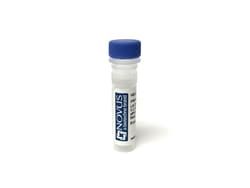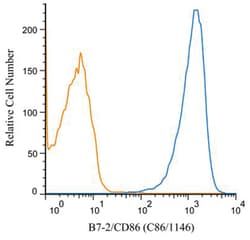CD25/IL-2R alpha Antibody (143-13) - Azide and BSA Free, Novus Biologicals™
Mouse Monoclonal Antibody
Manufacturer: Fischer Scientific
The price for this product is unavailable. Please request a quote
Antigen
CD25/IL-2 R alpha
Concentration
1.0 mg/mL
Applications
Flow Cytometry, Immunofluorescence, CyTOF
Conjugate
Unconjugated
Host Species
Mouse
Research Discipline
Adaptive Immunity, Apoptosis, B Cell Development and Differentiation Markers, Cytokine Research, Diabetes Research, Immunology, Innate Immunity, Mast Cell Markers, Signal Transduction
Formulation
PBS with No Preservative
Gene ID (Entrez)
3559
Immunogen
Stimulated human leukocytes
Primary or Secondary
Primary
Content And Storage
Store at 4C short term. Aliquot and store at -20C long term. Avoid freeze-thaw cycles.
Molecular Weight of Antigen
55 kDa
Clone
143-13
Dilution
Flow Cytometry : 0.5 - 1 ug/million cells in 0.1 ml, Immunofluorescence : 0.5 - 1.0 ug/ml, CyTOF-ready
Classification
Monoclonal
Form
Purified
Regulatory Status
RUO
Target Species
Human
Gene Alias
CD25, CD25 antigen, IDDM10, IL-2 receptor subunit alpha, IL2R, IL-2R subunit alpha, IL-2-RA, IL2-RA, interleukin 2 receptor, alpha, interleukin-2 receptor subunit alpha, p55, TAC antigen, TCGFR
Gene Symbols
IL2RA
Isotype
IgG1 κ
Purification Method
Protein A or G purified
Test Specificity
Recognizes a protein of 55kDa, identified as CD25. It is expressed on activated T- and B-cells and activated monocytes/macrophages. With respect to lymphomas, CD25 is present on malignant cells of Hodgkin's disease, HTLV-1+ adult T-cell leukemia, cutaneous T-cell lymphoma, and hair cell leukemia. Increased levels of soluble CD25 are observed in the leukemias/lymphomas and inflammatory/ autoimmune diseases. CD25 molecule alone appears to function as a low affinity receptor and associates with CD122 (IL-2R chain, p75) and CD132 (common chain) to form the high affinity IL-2 receptor complex. CD25 antibodies detect three epitope regions, A, B and C. This MAb recognizes the epitope B, which is located at residue 3-104 of CD25 and doe not block IL-2 binding to CD25.
Description
- CD25/IL-2R alpha Monoclonal specifically detects CD25/IL-2R alpha in Human samples
- It is validated for Flow Cytometry, Immunocytochemistry/Immunofluorescence, Functional, Immunofluorescence, CyTOF-ready.

